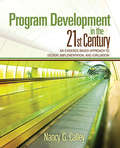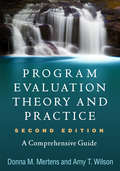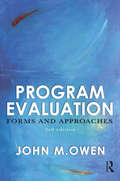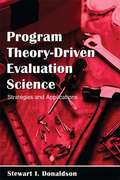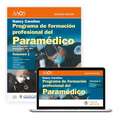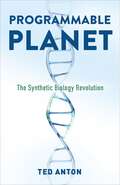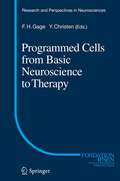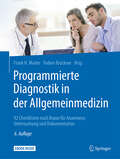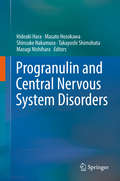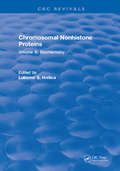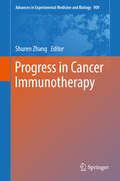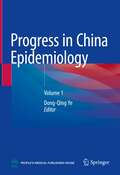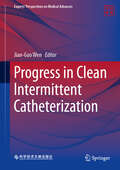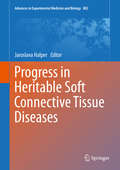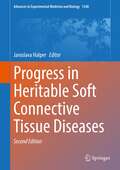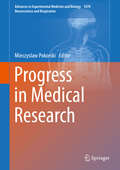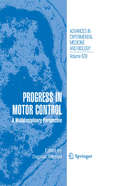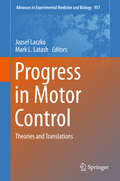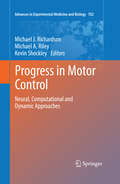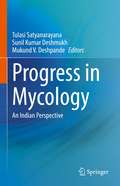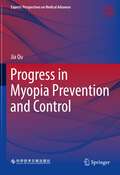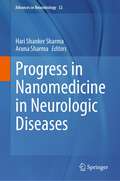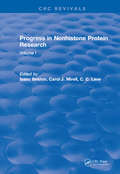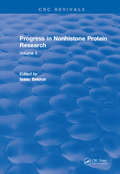- Table View
- List View
Program Development in the 21st Century: An Evidence-Based Approach to Design, Implementation, and Evaluation
by Nancy G. CalleyOffering practical strategies and tools readers can use on the job, this comprehensive book covers the practices, conditions, and legislative issues that affect program development. Using a unique 14-step model, the author guides readers through every stage of the process, from identifying a need, establishing a research basis, and designing the clinical program through implementing, evaluating, and sustaining the program. This valuable work captures the most significant changes that have occurred in human services and mental health program development over the last decade and demonstrates the need for mental health professionals to be well versed in business, management, and research as well as in clinical skills.
Program Evaluation Theory and Practice, Second Edition: A Comprehensive Guide
by Donna M. Mertens Amy T. WilsonThe leading text that covers both the theory and practice of evaluation in one engaging volume has now been revised and updated with additional evaluation approaches (such as mixed methods and principles-focused evaluation) and new methods (such as technologically based strategies). The book features examples of small- and large-scale evaluations from a range of fields, many with reflective commentary from the evaluators; helpful checklists; and carefully crafted learning activities. Major theoretical paradigms in evaluation--and the ways they inform methodological choices--are explained. Readers learn effective strategies for clarifying their own theoretical assumptions; working with stakeholders; developing questions; using quantitative, qualitative, and mixed methods designs; selecting data collection and sampling strategies; analyzing data; and communicating and utilizing findings. The new companion website provides extensive recommended online resources and tools, organized by chapter. New to This Edition *Additional evaluation approaches: collaborative evaluation, principles-focused evaluation, and desk reviews. *Coverage of new data collection technologies and methods of qualitative coding. *Expanded discussions of logic models, cost–benefit analysis, and mixed methods designs. *Many new and updated sample studies. Pedagogical Features *Reflection questions that prepare students to read each chapter. *"Extending Your Thinking" questions and practical activities. *Boxes delving into key concepts and example studies. *End-of-book Glossary, and highlighted key terms throughout. *Companion website with links to helpful resources on all aspects of evaluation.
Program Evaluation: Forms and approaches
by John M OwenProgram Evaluation 3rd edition has the hallmarks of thoroughness, insight and fluency of other editions but brings us up to date with a map of the evaluation territory new travelers will find invaluable.'Professor Murray Saunders, UK and European Evaluation Societies John Owen's Program Evaluation helps practitioners clarify distinctions between what we evaluate, the various motivations for conducting evaluation, and the approaches attendant to each. Timely evaluation examples liberally sprinkled throughout this book make it exceptionally useful and helpful to practitioners. I highly recommend Program Evaluation.'Professor Marvin Alkin, UCLA Graduate School of Education + Information StudiesEveryone involved with policy and program development and delivery is being asked to plan more carefully, reflect more critically and justify their decisions. The key to this is evaluation. Program Evaluation offers a conceptual yet straightforward and practical overview of the evaluation process for both beginners and experienced practitioners. It shows evaluators how to identify appropriate forms, approaches and methods, using an original framework. John Owen examines the contributions of evaluation to program provision, and offers proven techniques for involving stakeholders in the planning process and for disseminating the evaluation findings.This third edition has been thoroughly revised to incorporate recent research on evaluation and new examples of good practice. It includes sections of management of evaluation, negotiating evaluation plans, program logic and ex ante evaluation, evidence based practice, performance management and accountability.With international examples from a range of health, education, welfare, community and other settings, Program Evaluation is an essential reference for anyone involved in evaluation in both the public and private sectors.
Program Theory-Driven Evaluation Science: Strategies and Applications
by Stewart I. DonaldsonProgram Theory-Driven Evaluation Science fills the gap between 21st century literature on evaluation and what is happening in practice. It features detailed examples of how evaluations actually unfold in practice to develop people, programs, and organizations. Commonly accepted strategies for practicing evaluation are outlined, followed by comprehe
Programa de Formación Profesional del Paramédico. Nancy Caroline. Volumen 1 Impreso, Volumen 2 libro electrónico. En español.
by American Academy of Orthopaedic Surgeons (AAOS)El Programa de Formación Profesional del Paramédico, de Nancy Caroline, segunda edición, es la evolución más reciente del principal programa de formación académica para paramédicos.
Programmable Planet: The Synthetic Biology Revolution
by Ted AntonA new science is reengineering the fabric of life. Synthetic biology offers bold new ways of manufacturing medicines, clothing, foods, fragrances, and fuels, often using microbe fermentation, much like brewing beer. The technology can help confront climate change, break down industrial pollutants, and fight novel viruses. Today, researchers are manipulating life forms and automating evolution to create vegetarian “meat,” renewable construction materials, and cancer treatments. In the process, they are changing our concept of what life science can achieve. Is this a new industrial and information revolution—or dangerous tinkering that could unleash unintended consequences?Programmable Planet is a grand tour through the world of synthetic biology, telling the stories of the colorful visionaries whose ideas are shaping discoveries. Ted Anton explores the field from its beginning in fighting malaria in Africa to the COVID vaccines and beyond. Covering medical and agricultural triumphs and blunders, he examines successes in energy production, plant gene editing, and chemical manufacturing, as well as the most controversial attempts at human gene enhancement. This book reports from the front lines of research, showing policy makers’ struggle to stay abreast of the technologies they aim to regulate. Even-handed, lively, and informative, Programmable Planet gives a glimpse of the promise and problems of a new biology-based industry.
Programmed Cells from Basic Neuroscience to Therapy
by Yves Christen Fred H. GageThe recent advances in Programming Somatic Cell (PSC) including induced Pluripotent Stem Cells (iPS) and Induced Neuronal phenotypes (iN), has changed our experimental landscape and opened new possibilities. The advances in PSC have provided an important tool for the study of human neuronal function as well as neurodegenerative and neurodevelopmental diseases in live human neurons in a controlled environment. For example, reprogramming cells from patients with neurological diseases allows the study of molecular pathways particular to specific subtypes of neurons such as dopaminergic neurons in Parkinson's Disease, Motor neurons for Amyolateral Sclerosis or myelin for Multiple Sclerosis. Detecting disease-specific molecular signatures in live human brain cells, opens possibilities for early intervention therapies and new diagnostic tools. Importantly, once the neurological neural phenotype is detected in vitro, the so-called "disease-in-a-dish" approach allows for the screening of drugs that can ameliorate the disease-specific phenotype. New therapeutic drugs could either act on generalized pathways in all patients or be patient-specific and used in a personalized medicine approach. However, there are a number of pressing issues that need to be addressed and resolved before PSC technology can be extensively used for clinically relevant modeling of neurological diseases. Among these issues are the variability in PSC generation methods, variability between individuals, epigenetic/genetic instability and the ability to obtain disease-relevant subtypes of neurons . Current protocols for differentiating PSC into specific subtypes of neurons are under development, but more and better protocols are needed. Understanding the molecular pathways involved in human neural differentiation will facilitate the development of methods and tools to enrich and monitor the generation of specific subtypes of neurons that would be more relevant in modeling different neurological diseases.
Programmierte Diagnostik in der Allgemeinmedizin: 92 Checklisten nach Braun für Anamnese, Untersuchung und Dokumentation (Neue Allgemeinmedizin Ser.)
by Frank H. Mader Torben BrücknerPraxisgerechte Erhebung von Befund, Diagnostik und Verlauf 92 Checklisten zu Problemfällen mit einführenden Vortexten - Standardisierte Befragung und Untersuchung des Patienten - Rationelle Stufendiagnostik in Praxis und Spezialbereich - Die wichtigsten abwendbar gefährlichen Verläufe und ähnlichen Beschwerdebilder Personalisiertes Qualitätsmanagement im Praxisalltag - Leitlinienorientierte Grundlagen - Validierte Scores - Optimale Dokumentation von Beratungsursache und Befund Einheitlicher Aufbau der Checklisten - Was sagt der Patient? Was fragt der Arzt? - Was untersucht der Arzt? Was dokumentiert er? Ihr besonderer Service Alle Checklisten finden Sie auf www.springermedizin.de/checklisten-allgemeinmedizin. Für jede Nutzungsform: Zum elektronischen Ausfüllen innerhalb der Datei, zur handschriftlichen Dokumentation bei Papierausdruck, zum Abspeichern. Zusatzwissen über „Mader: Fakten – Fälle – Fotos“ www.fakten-faelle-fotos.de. Umfassendes, gezieltes und reproduzierbares Vorgehen - für alle Primärversorger: Allgemeinärzte, Internisten, Pädiater, Gynäkologen. Neue Checklisten: Müdigkeit, Familienproblematik, Schlaganfall, akuter Hörverlust, sexuelle Problematik, Beinödeme, Geriatrie, Augen, Kopfprellung, Suizidalität. Entspanntes Arbeiten auf hohem Niveau - Ergebnis jahrzehntelanger Praxisforschung. „Die Programmierte Diagnostik ist instruktiv und praxisnah. Sie bildet wesentliche allgemeinmedizinische Denkmuster und Vorgehensweisen in der gesamten klinischen sowie bio-psycho-sozialen Breite des Faches ab.“Prof. Dr. med. Martin SchererVizepräsident der Deutschen Gesellschaft für Allgemeinmedizin und Familienmedizin
Progranulin and Central Nervous System Disorders
by Hideaki Hara Masato Hosokawa Shinsuke Nakamura Takayoshi Shimohata Masugi NishiharaThis book presents the latest knowledge on the roles of progranulin (PGRN) in normal physiology and pathology and explores the emerging significance of PGRN as a therapeutic target and biomarker in various CNS disorders, including frontotemporal lobe degeneration and other neurodegenerative diseases. Following initial recognition of the importance of PGRN in sexual differentiation of the developing brain and adult neurogenesis, it was subsequently discovered that PGRN acts as a chaperone of lysosomal enzymes and plays a crucial role in maintaining cellular protein homeostasis. It has also been found that sex steroids modulate the expression of PGRN and its trophic effects in the developing CNS and that PGRN directly or indirectly influences neural stem and progenitor cells. Against this background, deeper understanding of the molecular and functional properties of PGRN would provide fresh impetus for the development of mechanism-based therapeutic approaches for multiple disorders. Medications targeting the recovery of lysosomal function appear to hold particular promise in patients with neurodegenerative diseases resulting from PGRN insufficiency. In examining multiple aspects of this fascinating field, the book will be of high value for researchers and graduate students.
Progress In Nonhistone Protein Research: Volume III
by I. BekhorAs a follow-up to Volumes I and II in this series, in this volume the authors attempt to provide an update into the current research in NHCP with the hope that these articles may foster a more analytical elucidation of the role of these proteins in gene expression.
Progress in Cancer Immunotherapy
by Shuren ZhangThisbook provides readers an extensive overview of recent progress in basicand clinical research on cancer immunotherapy. Thanks to rapid advances inmolecular biology and immunology, it has become increasingly evident thatcancer growth is influenced by host immune responses. With the success of anumber of clinical trials, immunotherapy has become a promising treatmentmodality of cancer. This book covers five major topics, including monoclonalantibodies, biological response modifiers, cancer vaccines, adoptive cellulartherapy and oncolytic viruses. It also examines the combination of differentimmune strategies as well as the combination of immunotherapy with othertreatments to increase anti-tumor effects. Throughthecomprehensive discussion of the topic, the book sheds valuable new light on thetreatment of tumors.
Progress in China Epidemiology: Volume 1
by Dong-Qing YeThis book is intended to show the great achievements and valuable experience of Chinese public health practices and epidemiological theories and methods. It is conducive to expanding medical workers’ practical ability of disease prevention and control, and to bridging the gap between clinical medicine and public health.In part 1, it introduces the progress in epidemiology of 10 infectious diseases. In part 2, it covers 11 non-communicable diseases. The research method and prediction modelling and public health ethics are discussed in the 11 chapters of part 3. The contributors include epidemiologists and public health experts, as well as more clinicians, mathematicians, sociologists, philosophers (ethicists), bioinformatics and so on. Among them, there are not only professors from universities, but also researchers from scientific research institutes, and experts in the front line of disease prevention and control.
Progress in Clean Intermittent Catheterization (Experts' Perspectives on Medical Advances)
by Jian-Guo WenThis book describes the clinical application of clean intermittent catheterization (CIC), a method regularly emptying the bladder under clean conditions by using a catheter through the urethra or cystostomy. First chapters introduce the basic knowledge and operation methods of CIC, and following chapters cover the clinical application of CIC, the evaluation and follow-up of CIC. The relevant operation of CIC is illustrated in detail. It is an important reference book for medical staff, graduate students and undergraduate students who are engaged in the diagnosis and treatment of various disorders of urination, especially for medical staff of urology, pediatric surgery (pediatric urology), rehabilitation department and neurology department, and for urinary control and stoma nursing staff, as well as for patients who need CIC.
Progress in Heritable Soft Connective Tissue Diseases
by Jaroslava HalperThis volume is a reference handbook focusing on diseases like Marfan syndrome, Ehlers-Danlos syndrome, Loeys-Dietz syndrome and other heritable soft connective tissue diseases. The book presents detailed information for both basic scientists and for clinicians seeing patients. It is also a stepping stone for new investigations and studies that goes beyond the facts about the composition and biochemistry of the connective tissue and extracellular matrix, as the authors connect individual components to specific aspects of various soft tissue disorders and to the actual or potential treatment of them. Progress in Heritable Soft Connective Tissue Diseases features very prominent physicians and scientists as contributors who bring their most recent discoveries to the benefit of readers. Their expertise will help clinicians with proper diagnosis of sometimes elusive and uncommon heritable diseases of soft connective tissues. This book also offers an update on the pathophysiology of these diseases, including an emphasis on unifying aspects such as connections between embryonic development of the different types of connective tissues and systems, and the role of TGF-beta in development and physiology of soft tissues. This new set of data explains, at least in part, why many of these disorders are interconnected, though the primary pathophysiological events, such as gene mutations, may be different for each disorder.
Progress in Heritable Soft Connective Tissue Diseases (Advances in Experimental Medicine and Biology #1348)
by Jaroslava HalperThis volume represents a substantially revised and updated 2nd edition of a reference handbook on major structural components of soft connective tissues and a whole slew of heritable diseases of soft connective tissues. The number of clearly identifiable and distinct disorders has grown somewhat since the 1st edition in 2014, e.g., Ehlers-Danlos syndrome has now 13 entities. A brand new syndrome, Meester Loeys syndrome carrying the name of Bart Loeys was added as a companion to Loeys-Dietz syndrome. Numerous variations of cutis laxa and joint mobility disorders have been discovered taking advantage of recent advancements in genetic analysis. We have acquired better understanding of pathogenesis and biochemical changes in some other, more established entities, such as Marfan and collagen VI myopathies where better management and possible treatment are on the horizon. Even in the case of connective tissue diseases in domestic animals some progress has been made. All these updates were contributed by a group of distinguished and preeminent physicians and scientists, all of them not just working in the field but making new discoveries described by them.Readers will notice that seemingly there is an overlap among many of these disorders. And indeed, many of them, if not most are interconnected because of the prominent roles of TGFβ, of fibrillin microfibrils and collagen fibril assembly (and other molecules) playing in connective tissues physiology, and by extension in pathogenesis of many disorders described in the book. What I found particularly helpful that author(s) of each chapter bring their own perspective even when described closely related mechanism of the disease. These observations should help with diagnosis and management of such cases.The first chapters are more general, concentrating more on the physiology, structure and biochemistry of normal soft tissues. That should help in better understanding of the pathophysiology. Last but not least, the chapters are very readable, more like detective stories than dry description of genetic/biochemical defects. I do hope that basic scientists and clinicians with similar and diverse interests alike will appreciate this volume and will be inspired by it to develop their research in the field.
Progress in Industrial Mathematics at ECMI 2016 (Mathematics In Industry Ser. #26)
by Peregrina Quintela Dolores Gómez Pilar Salgado Patricia Barral Francisco J. Pena Jerónimo Rodríguez Miguel E. Vázquez-MéndezThis book addresses mathematics in a wide variety of applications, ranging from problems in electronics, energy and the environment, to mechanics and mechatronics. Using the classification system defined in the EU Framework Programme for Research and Innovation H2020, several of the topics covered belong to the challenge climate action, environment, resource efficiency and raw materials; and some to health, demographic change and wellbeing; while others belong to Europe in a changing world – inclusive, innovative and reflective societies.The 19th European Conference on Mathematics for Industry, ECMI2016, was held in Santiago de Compostela, Spain in June 2016. The proceedings of this conference include the plenary lectures, ECMI awards and special lectures, mini-symposia (including the description of each mini-symposium) and contributed talks.The ECMI conferences are organized by the European Consortium for Mathematics in Industry with the aim of promoting interaction between academy and industry, leading to innovation in both fields and providing unique opportunities to discuss the latest ideas, problems and methodologies, and contributing to the advancement of science and technology. They also encourage industrial sectors to propose challenging problems where mathematicians can provide insights and fresh perspectives. Lastly, the ECMI conferences are one of the main forums in which significant advances in industrial mathematics are presented, bringing together prominent figures from business, science and academia to promote the use of innovative mathematics in industry.
Progress in Medical Research (Advances in Experimental Medicine and Biology #1070)
by Mieczyslaw PokorskiThis book is a compendium of articles providing insights into a range of contemporary ideas concerning the core yet unsettled clinical issues. Important aspects of pulmonary disorders are tackled such as occupational respiratory health hazards, asthma, or the role of vitamin D in obstructive airway diseases. Genotyping offers a clear promise in the diagnostics of chronic pulmonary lesions of autoimmune background. Cardiac and respiratory-driven pulsation of cerebrospinal fluid content offers novel arguments in the pathophysiologic savvy of a range of brain dysfunctional conditions, including respiratory-related hypoxic pathologies. Some other articles tackle the heady topics of rehabilitation medicine, offering an insight into research-underpinned diagnostics and practical management solutions in a range of musculoskeletal disorders and injuries that affect the human body's movement, particularly those controlled by the autonomic nervous system. The book is addressed to clinicians, researchers, physiotherapists, and medical professionals engaged in patient care.
Progress in Motor Control
by Dagmar SternadThis ground-breaking book brings together researchers from a wide range of disciplines to discuss the control and coordination of processes involved in perceptually guided actions. The research area of motor control has become an increasingly multidisciplinary undertaking. Understanding the acquisition and performance of voluntary movements in biological and artificial systems requires the integration of knowledge from a variety of disciplines from neurophysiology to biomechanics.
Progress in Motor Control
by Jozsef Laczko Mark L. LatashThis single volume brings together both theoretical developments in the field of motor control and their translation into such fields as movement disorders, motor rehabilitation, robotics, prosthetics, brain-machine interface, and skill learning. Motor control has established itself as an area of scientific research characterized by a multi-disciplinary approach. Its goal is to promote cooperation and mutual understanding among researchers addressing different aspects of the complex phenomenon of motor coordination. Topics covered include recent theoretical advances from various fields, the neurophysiology of complex natural movements, the equilibrium-point hypothesis, motor learning of skilled behaviors, the effects of age, brain injury, or systemic disorders such as Parkinson's Disease, and brain-computer interfaces.
Progress in Motor Control
by Michael J. Richardson Kevin Shockley Michael A. RileyThis volume is the most recent installment of the Progress in Motor Control series. It contains contributions based on presentations by invited speakers at the Progress in Motor Control VIII meeting held in Cincinnati, OH, USA in July, 2011. Progress in Motor Control is the official scientific meeting of the International Society of Motor Control (ISMC). The Progress in Motor Control VIII meeting, and consequently this volume, provide a broad perspective on the latest research on motor control in humans and other species.
Progress in Mycology: An Indian Perspective
by Tulasi Satyanarayana Sunil Kumar Deshmukh Mukund V. DeshpandeIndian mycologists have extensively studied various groups of fungi such as soil fungi, aquatic fungi, marine fungi, endophytic fungi, fungi associated with man and animals. Though several books on various aspects of fungi are published, this is the first account of the history and developments in mycology in India. It discusses at length various stages of development of mycology including both classical and biotechnological aspects. It begins with a historical account of Indian mycology, followed by a description of research on fossil fungi. Further chapters cover the latest updates on different taxonomic groups of fungi. A dedicated section describes the roles and applications of fungal endophytes. The book also includes research in other important areas such as mushrooms and wood rotting fungi. Different chapters are written by leading mycologists. This book is useful to students, teachers and researchers in botany, microbiology, biotechnology and life sciences, agriculture and industries using fungi to produce various valuable products.
Progress in Myopia Prevention and Control (Experts' Perspectives on Medical Advances)
by Jia QuThis book provides a systematic summary of the latest advancements in myopia research, as well as practical experience in myopia prevention and control. The author emphasizes the importance of effectively disseminating information about myopia prevention and control to a wide audience. It highlights four effective strategies to control the progression of myopia, such as orthokeratology lens wear, wearing multifocal soft contact lenses, eye drops with low concentration of atropine, and wearing spectacles. This book aims to promote and popularize the scientific knowledge of myopia prevention and control effectively, providing a model and template for achieving this goal.
Progress in Nanomedicine in Neurologic Diseases (Advances in Neurobiology #32)
by Aruna Sharma Hari Shanker SharmaThis book covers the use of nanomedicine in the delivery of neuroprotective agents, including pharmacological drugs, stem cells, neurotrophic factors, monoclonal antibodies and enzymes to induce greater beneficial effects in neurologic diseases. Thus, the main purpose of the book is to explore the delivery of drugs either alone or in combination with stem cells to enhance neuroprotection in neurological diseases. Brain pathology associated with acute trauma such as head injury and brain blast injury can also be managed using novel treatment strategies. In addition, emphasis is made that standard patterns of brain pathology may be complicated with multiple comorbidity factors where one agent alone is not sufficient to induce brain protection. Enzymes and antibodies may help in combination and enhance the efficacy when administered through nanotechnology. Progress in Nanomedicine in Neurologic Diseases will encourage further research in the field of neuroprotection, brain injury, neurodegenerative diseases, neuropharmacology, neuropathology, and neurology. Students and researchers along with policy makers, teachers and health care professionals may also benefit from the findings of the book for enhanced patients care.
Progress in Nonhistone Protein Research: Volume I
by I. Bekhor IsaacThe purpose of this text is to encourage research on nonhistones and to stimulate the imagination of other investigators whose future efforts might result in new discoveries as to the significance of these proteins.
Progress in Nonhistone Protein Research: Volume II
by I. Bekhor IsaacThe purpose of this text is to encourage research on nonhistones and to stimulate the imagination of other investigators whose future efforts might result in new discoveries as to the significance of these proteins.
